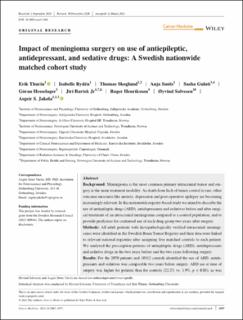| dc.contributor.author | Thurin, Erik | |
| dc.contributor.author | Rydén, Isabelle | |
| dc.contributor.author | Skoglund, Thomas | |
| dc.contributor.author | Smits, Anja | |
| dc.contributor.author | Gulati, Sasha | |
| dc.contributor.author | Hesselager, Göran | |
| dc.contributor.author | Bartek, Jiri Jr. | |
| dc.contributor.author | Henriksson, Roger | |
| dc.contributor.author | Salvesen, Øyvind | |
| dc.contributor.author | Jakola, Asgeir Store | |
| dc.date.accessioned | 2021-06-28T10:45:15Z | |
| dc.date.available | 2021-06-28T10:45:15Z | |
| dc.date.created | 2021-03-28T17:14:13Z | |
| dc.date.issued | 2021 | |
| dc.identifier.citation | Cancer Medicine. 2021, 10 (9), 2967-2977. | en_US |
| dc.identifier.issn | 2045-7634 | |
| dc.identifier.uri | https://hdl.handle.net/11250/2761596 | |
| dc.description.abstract | Background: Meningioma is the most common primary intracranial tumor and surgery is the main treatment modality. As death from lack of tumor control is rare, other outcome measures like anxiety, depression and post-operative epilepsy are becoming increasingly relevant. In this nationwide registry-based study we aimed to describe the use of antiepileptic drugs (AED), antidepressants and sedatives before and after surgical treatment of an intracranial meningioma compared to a control population, and to provide predictors for continued use of each drug-group two years after surgery. Methods: All adult patients with histopathologically verified intracranial meningiomas were identified in the Swedish Brain Tumor Registry and their data were linked to relevant national registries after assigning five matched controls to each patient. We analyzed the prescription patterns of antiepileptic drugs (AED), antidepressants and sedative drugs in the two years before and the two years following surgery. Results: For the 2070 patients and 10312 controls identified the use of AED, antidepressants and sedatives was comparable two years before surgery. AED use at time of surgery was higher for patients than for controls (22.2% vs. 1.9%, p < 0.01), as was antidepressant use (12.9% vs. 9.4%, p < 0.01). Both AED and antidepressant use remained elevated after surgery, with patients having a higher AED use (19.7% vs. 2.3%, p < 0.01) and antidepressant use (14.8% vs. 10.6%, p < 0.01) at 2 years post-surgery. Use of sedatives peaked for patients at the time of surgery (14.4% vs. 6.1%, p < 0.01) and remained elevated at two years after surgery with 9.9% versus 6.6% (p < 0.01). For all the studied drugs, previous drug use was the strongest predictor for use 2 years after surgery. Conclusion: This nationwide study shows that increased use of AED, antidepressants and sedatives in patients with meningioma started perioperatively, and remained elevated two years following surgery. | en_US |
| dc.language.iso | eng | en_US |
| dc.publisher | John Wiley & Sons Ltd. | en_US |
| dc.rights | Navngivelse 4.0 Internasjonal | * |
| dc.rights.uri | http://creativecommons.org/licenses/by/4.0/deed.no | * |
| dc.title | Impact of meningioma surgery on use of antiepileptic, antidepressant, and sedative drugs: A Swedish nationwide matched cohort study | en_US |
| dc.type | Peer reviewed | en_US |
| dc.type | Journal article | en_US |
| dc.description.version | publishedVersion | en_US |
| dc.source.pagenumber | 2967-2977 | en_US |
| dc.source.volume | 10 | en_US |
| dc.source.journal | Cancer Medicine | en_US |
| dc.source.issue | 9 | en_US |
| dc.identifier.doi | 10.1002/cam4.3868 | |
| dc.identifier.cristin | 1901515 | |
| dc.description.localcode | This is an open access article under the terms of the Creative Commons Attribution License, which permits use, distribution and reproduction in any medium, provided the original work is properly cited. | en_US |
| cristin.ispublished | true | |
| cristin.fulltext | original | |
| cristin.qualitycode | 1 | |

